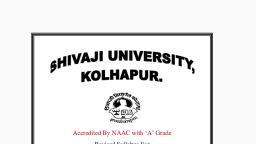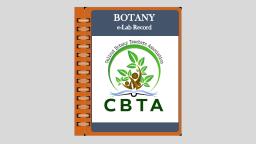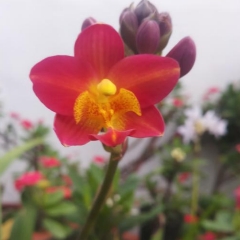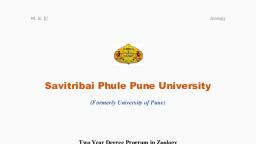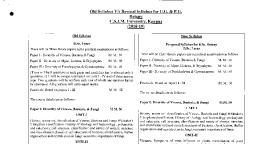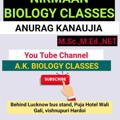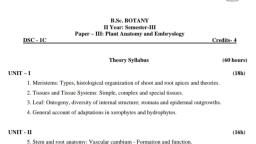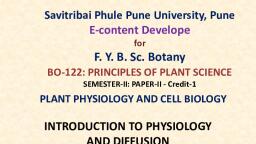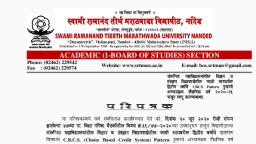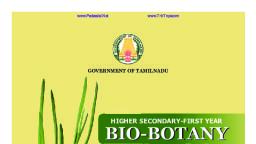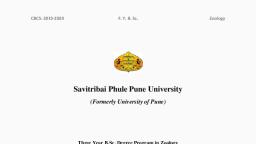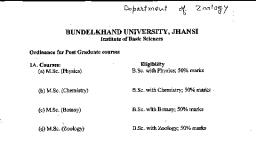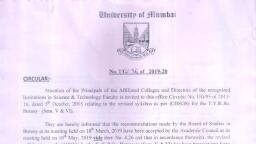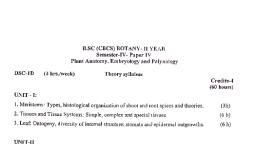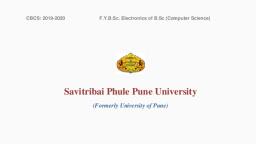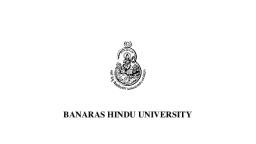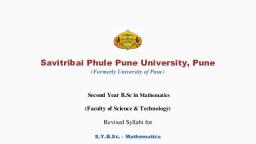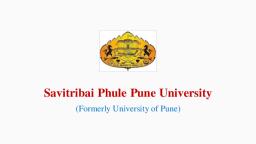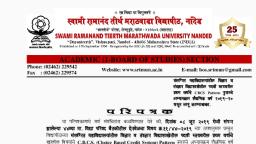Page 1 :
CBCS: 2019-2020, , F. Y. B. Sc., , Botany, , Savitribai Phule Pune University, (Formerly University of Pune), , Three Year B.Sc. Degree Program in Botany, (Faculty of Science & Technology), , F.Y.B.Sc. Botany, , Choice Based Credit System Syllabus, To be implemented from Academic Year 2019-2020, , Savitribai Phule Pune University, , Page 1
Page 2 :
CBCS: 2019-2020, , F. Y. B. Sc., , Botany, , Title of the Course: B. Sc Botany, 1. Structure of Course:, Structure B.Sc. Botany syllabus, Year Semester Course Type Course code Course Name, 1, 1, Compulsory BO 111, Plant life and utilization I, Course, BO 112, Plant morphology and Anatomy, BO 113, Practical based on BO 111 & BO, 112, 2, Compulsory BO 121, Plant life and utilization II, Course, BO 122, Principles of plant science, BO 123, Practical based on BO 121 & BO, 122, 2, 3, Compulsory BO 231, Botany Theory Paper 1, Course, BO 232, Botany Theory Paper 2, BO 233, Botany Practical Paper, 4, Compulsory BO 241, Botany Theory Paper 1, Course, BO 242, Botany Theory Paper 2, BO 243, Botany Practical Paper, 3, 5, Discipline, BO 351, Botany Theory Paper 1, Specific, BO 352, Botany Theory Paper 2, Elective, BO 353, Botany Theory Paper 3, Course, BO 354, Botany Theory Paper 4, BO 355, Botany Theory Paper 5, BO 356, Botany Theory Paper 6, BO 357, Botany Practical Paper 1, BO 358, Botany Practical Paper 2, BO 359, Botany Practical Paper 3, Skill, BO 3510, Botany Theory Paper 7, Enhancement BO 3511, Botany Theory Paper 8, course, 3, 6, Discipline, BO 361, Botany Theory Paper 1, Specific, BO 361, Botany Theory Paper 2, Elective, BO 362, Botany Theory Paper 3, Course, BO 363, Botany Theory Paper 4, BO 364, Botany Theory Paper 5, BO 365, Botany Theory Paper 6, BO 366, Botany Practical Paper 1, BO 367, Botany Practical Paper 2, BO 368, Botany Practical Paper 3, Skill, BO 3610, Botany Theory Paper 7, Enhancement BO 3611, Botany Theory Paper 8, course, Savitribai Phule Pune University, , Credits, 2, 2, 1.5, 2, 2, 1.5, 2, 2, 2, 2, 2, 2, 2, 2, 2, 2, 2, 2, 2, 2, 2, 2, 2, 2, 2, 2, 2, 2, 2, 2, 2, 2, 2, 2, , Page 2
Page 3 :
CBCS: 2019-2020, , F. Y. B. Sc., , Botany, , 2. Equivalence of Previous Syllabus:, Old Course (2013 Pattern), , New Course (2019 CBCS Pattern), , Fundamentals of Botany: PAPER – I, Term- I: Plant Diversity, , BO 111 Plant life and utilization I, , Botany Theory Paper II Term I –, Industrial Botany, , BO 112 Plant morphology and Anatomy, , Fundamentals of Botany: PAPER - I, Term- II: Morphology and Anatomy, , BO 121 Plant life and utilization II, , Botany Theory Paper II Term- II –, Industrial Botany, , BO 122 Principles of plant science, , F. Y. B. Sc. Botany Practical Paper - III, based on Theory Paper I and Paper II, , BO 113 Practical based on BO 111 & BO, 112 and, BO 123 Practical based on BO 121 & BO, 122, , Savitribai Phule Pune University, , Page 3
Page 4 :
CBCS: 2019-2020, , F. Y. B. Sc., , Botany, , SEMESTER-I: PAPER-I, BO-111: PLANT LIFE AND UTILIZATION I (30 Lectures), CREDIT-I, , 15 Lectures (15 Hours), , 1. INTRODUCTION, 3L, General outline of plant kingdom (Lower Cryptogams: ThallophytesAlgae, Fungi & Lichens; Higher Cryptogams: Bryophytes and, Pteridophytes; Phanerogams: Gymnosperms and AngiospermsDicotyledons and Monocotyledons). Distinguishing characters of these, groups and mention few common examples from each., 2. ALGAE, 9L, 2.1: Introduction, 2.2: General Characters, 2.3: Classification (Bold and Wynne 1978) up to classes with reasons, 2.4: Life Cycle of Spirogyra w.r.t. Habit, Habitat, Structure of thallus, structure, of typical cell, Reproduction- Vegetative, Asexual and Sexual, systematic, position with reasons, 2.5: Utilization of Algae in Biofuel Industry, Agriculture, Pharmaceuticals,, Food and Fodder, 3. LICHENS, 3.1: Introduction, 3.2: General Characters, 3.3: Nature of Association, forms- Crustose, Foliose and Fruticose., 3.4: Utilization of lichens., , 3L, , CREDIT-II, 15 Lectures (15 Hours), 4. FUNGI, 9L, 4.1: Introduction, 4.2: General Characters, 4.3: Classification (Ainsworth, 1973), 4.4: Life Cycle of Mushroom- Agaricus bisporus w.r.t. Habit, Habitat, Structure, of thallus, Structure of Sporocarp, Structure of Gill, Reproduction- Asexual, and sexual, Systematic position., 4.5: Utilization of Fungi in Industry, Agriculture, Food and Pharmaceuticals., 5. BRYOPHYTES, 6L, 5.1: Introduction, 5.2: General Characters, 5.3: Classification (G.M. Smith 1955), 5.4: Life Cycle of Riccia w.r.t. Habit, habitat, external and internal structure of, thallus, Reproduction- vegetative, asexual and sexual- Structure of sex, organs, fertilization, structure of mature sporophyte, structure of spore,, systematic position with reasons., 5.5: Utilization: Bryophytes as ecological indicators, agriculture, fuel, industry, and medicine., (Development of sex organs not expected for all the above mentioned life cycles)., Savitribai Phule Pune University, , Page 4
Page 5 :
CBCS: 2019-2020, , F. Y. B. Sc., , Botany, , REFERENCES:, 1. Ainswarth, Sussman and Sparrow (1973). The Fungi. Vol. IV-A and IV-B. Academic, Press., 2. Bilgrami, K.S. and Saha, L.C. (1992) A Textbook of Algae. CBS Publishers and, Distributors, Delhi., 3. Gangulee, Das and Dutta (2002). College Botany. Vol. I, New Central Book Agency, (P) Ltd., 4. Dube, H.C. (1990). An Introduction to Fungi. Vikas Publishing House Pvt. Ltd., Delhi., 5. Krishnamurty, V. (2000). Algae of India and neighboring countries, Chlorophyta,, Oxford and IBH, New Delhi., 6. Parihar, N.S. (1980). Bryophyta, An Introduction of Embryophyta. Vol. I. Central, Book Distributors, Allahabad., 7. Puri, P. (1980). Bryophyta: Broad prospective. Atma Ram & Sons, Delhi., 8. Smith, G.M. (1971). Cryptogamic Botany. Vol. I: Algae & Fungi. Tata McGraw Hill, Publishing Co., New Delhi., 9. Smith, G.M. (1971). Cryptogamic Botany. Vol. II: Bryophytes & Pteridophytes. Tata, McGraw Hill Publishing Co., New Delhi., 10. Vashista, B.R., Sinha, A.K. and Singh, V.B. (2005). Botany for degree students- Algae,, S. Chand Publication., 11. Vashista, B.R., Sinha, A.K. and Singh, V.B. (2005). Botany for degree students- Fungi,, S. Chand Publication., 12. Vashista, B.R., Sinha, A.K. and Singh, V.B. (2005). Botany for degree studentsBryophytes, S. Chand Publication., , Savitribai Phule Pune University, , Page 5
Page 7 :
CBCS: 2019-2020, , CREDIT- II, , F. Y. B. Sc., , Botany, , 15 Lectures (15 Hours), , 3. ANATOMY:, 2L, 3.1 Introduction and definition, 3.2 Importance in Taxonomy, Physiology, Ecological interpretations, Pharmacongnosy, and Wood identification., 4. TYPES OF TISSUES:, 8L, Outline with brief description, simple and complex tissues., 4.1: Meristmatic tissues: Meristem, characters and types based on origin, position and, plane of division, functions., 4.2: Permanent tissues: Simple tissues - parenchyma, collenchymas, chlorenchyma, and sclerenchyma., 4.3: Complex/Vascular tissues: Components of xylem and phloem, types of vascular, bundles and functions., 4.4: Epidermal tissues: Epidermis, structure of typical stomata, trichomes, motor cells;, functions., 5. INTERNAL ORGANIZATION OF PRIMARY PLANT BODY:, 5.1: Internal structure of dicotyledon and monocotyledon root., 5.2: Internal structure of dicotyledon and monocotyledon stem., 5.3: Internal structure of dicotyledon and monocotyledon leaf., , 5L, , REFERENCES:, 1. Chandurkar, P.J. (1989). Plant Anatomy. Oxford and IBH Publishing Co. Pvt. Ltd.,, New Delhi., 2. Dutta, A.C. (2003). Botany for Degree students. Oxford University Press, New, Delhi., 3. Eames, J. and Mc. Daniels (1994). An Introduction to Plant Anatomy. Tata, McGraw Hill Publishing Comp., New Delhi., 4. Esau, K. (1993). Plant Anatomy. Wiley Eastern Ltd. New Delhi., 5. Esau, K. (2006). Anatomy of seed plants. John Wiley and Sons, New York., 6. Fahn, A. (1974). Plant Anatomy. Pergamum Press Oxford., 7. Gangulee, Das and Dutta (2002). College Botany. Vol. I. New Central Book, Agency, Kolkata., 8. Lawrence, G.H.M. (2012). Taxonomy of vascular Plants. Scientific Publishers, (India) Jodhpur., 9. Naik, V.N. (1994). Taxonomy of Angiosperms. Tata McGraw Hill Publishing, Comp., New Delhi., 10. Pandey, B.P. (2007). Plant Anatomy. S. Chand and Co. Ltd. New Delhi., 11. Pandey, B.P. (2009). A Text Book of Botany- Angiosperms. S. Chand and Co. Ltd., New Delhi., 12. Radford, Albert E. (1986). Fundamentals of Plant Systematics. Publ. Harper and, Row, New York., 13. Saxena, A.K. and Sarabhai, R.P. (1968). A Text Book of Botany. Vol. III. Ratan, Prakashan mandir, Agra., 14. Sharma, O.P. (1993). Plant Taxonomy. 2nd Edition, McGraw Hill Education, New, Delhi., 15. Singh, Gurucharan (2005). Systematics- Theory and Practice. Oxford IBH., 16. Sutaria, R.N.A. Text Book of Systematic Botany., 17. Tayal, M.S. (2012). Plant Anatomy. Rastogi Publications., Savitribai Phule Pune University, , Page 7
Page 9 :
CBCS: 2019-2020, , F. Y. B. Sc., , Botany, , SEMESTER-II: PAPER-I, BO-121: PLANT LIFE AND UTILIZATION-II (30 Lectures), CREDIT-I, , 15 Lectures (15 hours), , 1. INTRODUCTION: Introduction to plant diversity- Pteridophytes, Gymnosperms, and Angiosperms with reference to vascular plants., 3L, 2. PTERIDOPHYTES: General characters, Outline classification according to Sporne, (1976) up to classes with reasons. Life cycle of Nephrolepis w.r.t. Habit, habitat,, distribution, morphology, anatomy of stem and leaf, Reproduction – vegetative and, sexual., 10 L, 3. Utilization and economic importance of Pteridophytes., 2L, CREDIT-II, , 15 Lectures (15 hours), , 1. GYMNOSPERMS: General characters, Outline classification according to Sporne, (1977) up to classes with reasons. Life cycle of Cycas w.r.t. Habit, Habitat,, Distribution, Morphology and Anatomy of Stem, leaf and reproductive organs- Male, cone, Microsporophyll, microspores and megasporophyll, megaspore; structure of, seed; Utilization and economic importance of gymnosperms., 8L, 2. ANGIOSPERMS: General characters, Outline of classification of Bentham and, Hooker’s system up to series, comparative account of monocotyledons and, dicotyledons., 4L, 3. Utilization and economic importance of Angiosperms: In food, fodder, fibers,, horticulture and medicines., 3L, , REFERENCES:, 1. Bendre, Ashok and Kumar, Ashok (1993). A Text Book of Practical Botany,, Rastogy Publications, Meerut., 2. Chamberlain, C.J. (1934). Gymnosperms- Structure and Evolution. Chicago., 3. Coulter, J.M. and Chamberlain, C.J. (1917). Morphology of Gymnosperms., Chicago., 4. Davis, P.H. and Heywood, V.H. (1963). Principles of Angiosperms taxonomy., Oliver and Boyd Publ. London., 5. Dutta, S.C. (1988). Systematic Botany. Wiley Eastern Ltd., New Delhi., 6. Eames, E.J. (1983). Morphology of Vascular Plants. Standard University Press., 7. Gangulee and Kar (2006). College Botany. New Central Book Agency (P.) Ltd., Kolkata., 8. Naik, V.N. (1994). Taxonomy of Angiosperms. Tata McGraw Hill Publishing, Comp., New Delhi., 9. Parihar, N.S. (1976). Biology and Morphology of Pteridophytes. Central Book, Depot., 10. Rashid, A. (1999). An Introduction to Pteridophyta. Vikas Publishing House, Pvt. Ltd. New Delhi., 11. Sharma, O.P. (1990). Text Book of Pteridophyta. McMillan India Ltd. Delhi., 12. Singh, V. and Jain, D.K. (2010). Taxonomy of Angiosperms. Rastogy, Publications, Meerut., Savitribai Phule Pune University, , Page 9
Page 11 :
CBCS: 2019-2020, , F. Y. B. Sc., , Botany, , SEMESTER-II: PAPER-II, BO-122: PRINCIPLES OF PLANT SCIENCE, , (30 Lectures), , CREDIT-1: PLANT PHYSIOLOGY AND CELL BIOLOGY, 15 Lectures (15 Hours), 1. Introduction, definition and scope of plant physiology., 1L, 2. Diffusion – definition, importance of diffusion in plants, imbibition as a special, type of diffusion., 1L, 3. Osmosis – definition, types of solutions (hypotonic, isotonic, hypertonic),, endosmosis, exo-osmosis, osmotic pressure, turgor pressure, wall pressure,, importance of osmosis in plants., 2L, 4. Plasmolysis – definition, mechanism and significance., 1L, 5. Plant growth - introduction, phases of growth, factors affecting growth,, 2L, 6. Structure of plant cell, differences between prokaryotic and eukaryotic cell. 2 L, 7. Plant cell wall – components of primary cell wall, structure and functions., 1L, 8. Ultrastructure and functions of chloroplast, 2L, 9. Cell cycle in plants- importance of cell cycle in plants, divisional stages of mitosis, and meiosis., 3L, , CREDIT-II: MOLECULAR BIOLOGY, , (15 Lectures) 15 Hours, , 1. Introduction and scope of molecular biology, central dogma of molecular biology., 2L, 2. Structure of DNA, nucleoside and nucleotide, 2L, 3. Watson Crick model of DNA and its characteristic features, types of DNA (A, B, and Z DNA)., 3L, 4. Types of chromosomes., 2L, 5. Structure and types of RNA., 3L, 6. DNA replication- Types of replication (conservative, semi-conservative and, dispersive), enzymes involved, leading and lagging strands, Okazaki fragments., 3L, , REFERENCES:, 1. Buchanan, B.B, Gruissem, W. and Jones, R.L (2000). Biochemistry and, Molecular Biology of Plants. American Society of Plant Physiologists, Maryland, USA., 2. Cooper, G.M. and Hausman, R.E. (2007). The Cell: Molecular Approach 4th, Edition, Sinauer Associates, USA., 3. David, Nelson and Cox, Michael (2007). Lehninger Principles of Biochemistry., W.H. Freeman and Company. New York., 4. Devlin, R.M. (1983). Fundamentals of Plant Physiology. Mc. Millan, New, York., 5. Dutta, A.C. (2000). A Class Book of Botany. Oxford University Press, UK., 6. Hopkins, William G. (1995). Introduction to Plant Physiology. Publ. John, Wiley and Sons, Inc., Savitribai Phule Pune University, , Page 11
Page 12 :
CBCS: 2019-2020, , F. Y. B. Sc., , Botany, , 7. Lewin, Benjamin (2011). Genes. X Jones and Bartlett., 8. Lincolin, Taiz and Eduardo, Zeiger (2010). Plant Physiology. 5 th Edition., Sinauer Associates, Inc. Publishers. Sunder land, USA., 9. Opik, Helgi, Rolfe, Stephen A. and Willis, Arthur J. (2005). The Physiology of, Flowering Plants. Cambridge University Press, UK., 10. Pal, J.K. and Ghaskadbi, Saroj (2009). Fundamentals of Molecular Biology., Oxford University Press. India., 11. Pandey, S.N. and Sinha, B.K. (2014). Plant Physiology. Vikas Publishing, House Pvt. Ltd., India., 12. Salisbury, F.B. and Ross, C.B. (2005). Plant Physiology. 5 th Edition., Wadsworth Publishing Co. Belmont California, USA., 13. Watson, James D., Baker, Tania; Bell, Stephen P.; Alexander Gann; Levine,, Michael and Lodwick, Richard (2008). Molecular Biology of the Gene. 6th, Edition, Pearson Education, Inc. and Dorling Kindersley Publishing, Inc. USA., 14. Weaver, R. (2011). Molecular Biology. 5th Edition, Publisher- McGrew Hill, Science. USA., , BO 123: PRACTICALS BASED ON BO 121 & BO 122 (1.5 CREDITS), 1. Study of life cycle of Nephrolepis., 1P, 2. Study of life cycle of Cycas., 1P, 3. Study of Bentham and Hooker’s system of classification outline up to series with, example, 1P, 4. Study of comparative account of Dicotyledonous and Monocotyledonous plants, w.r.t to external morphological characters., 1P, 5. Study of utilization and economic importance of Angiosperms- food, fodder, fibers,, horticulture and medicines., 1P, 6. One day visit to study diversity of vegetation., 2P, 7. To observe characteristic features of prokaryotic and eukaryotic plant cell., 1P, 8. Staining of suitable nuclear material by Basic Fuchsin, 1P, 9. Study of mitosis- preparation of slides using onion root tips to observe divisional, stages., 1P, 10., Study of meiosis- preparation of slides using Tradescantia/ Rhoeo/ Maize /, Onion flower buds to observe divisional stages., 2P, 11. Estimation of chlorophyll-a and chlorophyll-b by using suitable plant material.1 P, 12. Plasmolysis- endosmosis, exosmosis, incipient plasmolysis using Rhoeo leaf, peeling and Demonstration of Osmosis- curling experiment., 1P, 13. Study of DPD by using suitable plant sample, 1P, , Savitribai Phule Pune University, , Page 12

